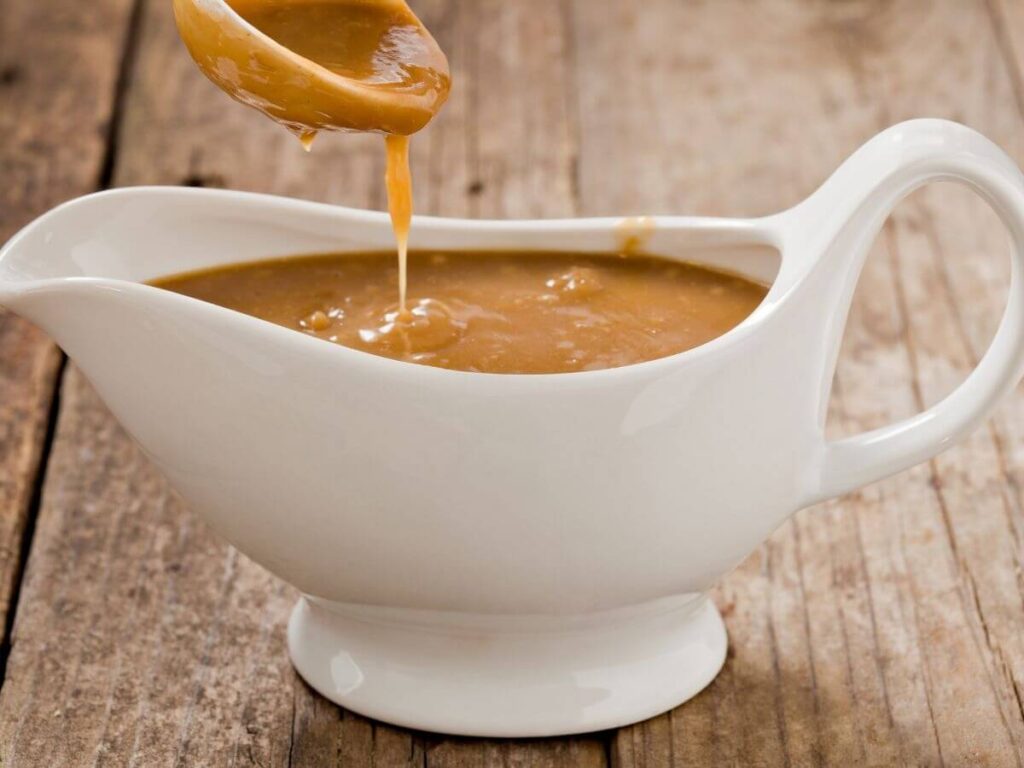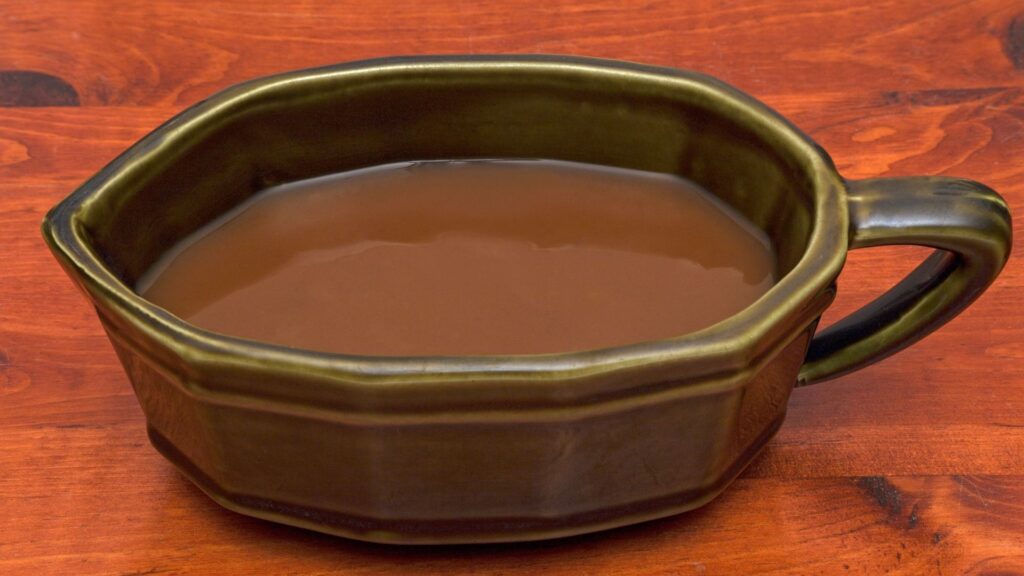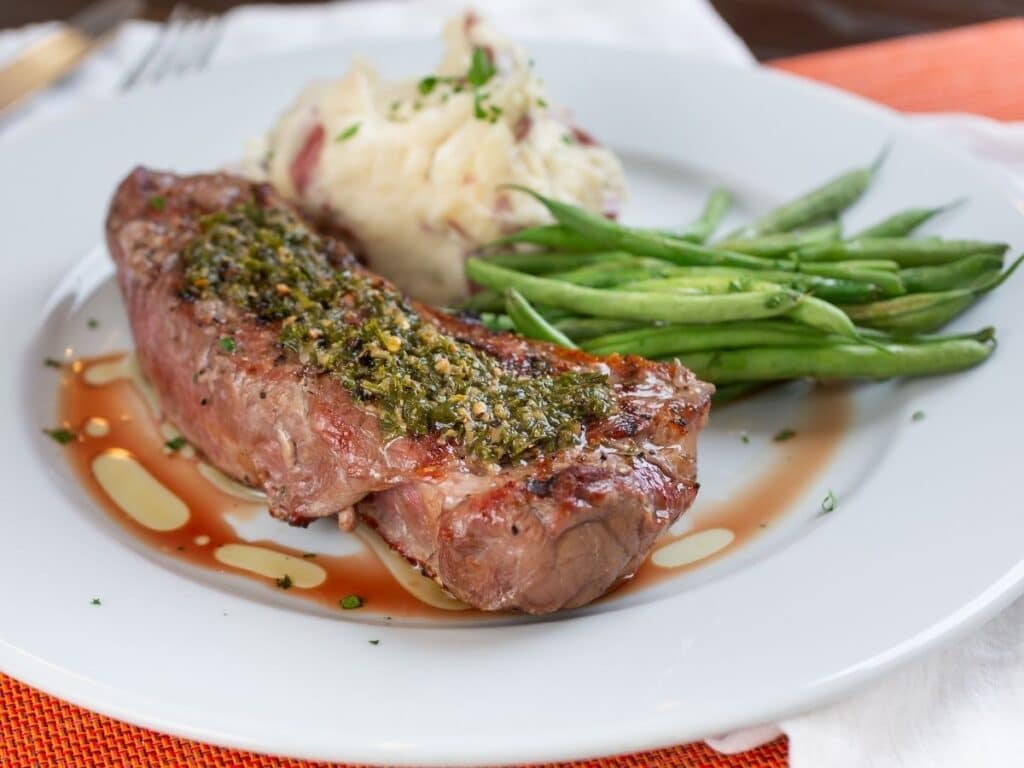
Want to know the secret sauce that will tie your entire meal together? It’s gravy! But don’t just settle for any gravy from the packet – instead, take a few minutes to whip up a homemade version. This guide will help you learn how to make beef gravy from drippings. It’s the best way to make zesty, tasty gravy from the meat you just cooked.
Learning how to cook is all about breaking things down into easy steps. Once you learn how to use a stove and a saucepan, you can now make recipes. Sure, it’s tempting to go the easy route and just use the packets of gravy, but you won’t believe how much tastier homemade gravy is – and it isn’t much more work, either.
That’s the funny myth about homemade food and home cooking. Just because it has a few more steps and ingredients doesn’t mean it is more complicated. In fact, they are often similar steps – combine the ingredients and heat them on the stove.
Beef gravy is one of the best things to learn how to cook from scratch. When you pour this gravy on top of mashed potatoes or meat, you’ll smell the savory aromas and see the bits of herbs and meat. It gives the entire dish a deeper and richer mouthfeel. As you’ll see below, it’s so easy and makes a huge difference in your meals.
What is Beef Gravy
Beef gravy is a sauce that people pour on top of meat and side dishes like mashed potatoes. It is also called brown gravy or pan gravy. Beef gravy is savory and usually made from a combination of meat drippings, beef stock, and spices.
It’s important to note that not all gravies are the same. Some people like thinner gravies, while others like to make theirs so thick that they don’t drip or run.
What are Beef Drippings
Before we look at how to make gravy from beef drippings, it’s important to understand what beef drippings are.
Beef drippings include anything left behind in the pan after you fry or sear your steak. This can include spices, herbs, and even some grease and bits of meat.
This is the stuff that usually just gets tossed out, but don’t toss anything out! They are a very important part of making homemade gravy.
Why Make Beef Gravy from Drippings

The drippings from your meat are filled with fats, spices, and bits of meat. These ingredients are very significant in the process of making homemade gravy.
The drippings will naturally season your gravy. You don’t have to worry about getting the spice levels just right – just focus on making the gravy thicker.
Plus, when you use pan drippings to make gravy, it will have similar spices and tastes as the meat you just cooked. This is an effortless way to make the entire dinner go together.
How to Make Beef Gravy from Drippings – Different Ways
There are many different ways to make pan gravy, and one isn’t better than another. It just depends on your personal tastes.
Sometimes the biggest differences between them are either how they are made or changing one minor ingredient. Once you learn the basics, you can make your gravy your way.
To get started, browse these popular ideas and gravy recipes and choose your favorite.
Classic Skillet Recipe
This skillet recipe is the most common and popular way to make brown gravy from beef drippings.
- First, melt some butter and flour in a hot skillet.
- Whisk them together until they form a paste and begin to brown.
- Then, slowly add your broth and beef drippings.
- Keep whisking quickly while you add them to the roux.
- Continue to stir this constantly until it begins to look like gravy.
- After all of your ingredients are combined, whisk them while bringing them to a boil.
- At this point, taste-test it and add more salt or spices if you think it needs it.
That’s it! Your gravy is ready to use.
Dairy-Free
The only dairy ingredient in a typical gravy is butter. If you are staying away from dairy, I suggest using ghee or coconut oil in its place. Ghee (clarified butter) works better and has a milder flavor, so I prefer it over coconut oil for making dairy-free homemade gravy.
Gluten-Free

It’s really easy to make gluten-free gravy. Just use your favorite 1:1 replacement gluten-free flour. Bob’s Red Mill makes a popular one. It behaves just like wheat flour.
Keto
People on a ketogenic diet cannot eat wheat flour or cornstarch because they have too many carbs. The easiest way to thicken pan drippings and turn them into gravy is to add a teaspoon of xanthan gum to the beef stock, ghee, and drippings. Whisk it constantly and bring it to a boil. It will thicken as it simmers.
Instant Pot
If you have an Instant Pot, I’ll tell you right now that it is just as easy to make gravy on the stove as it is in this Instant Pot. You’ll follow the same exact steps with both methods.
To make gravy in the Instant Pot, turn it to the saute function and follow the instructions from the classic skillet recipe above. You’ll make a roux, add more ingredients, and keep whisking until you’ve got gravy.
You don’t add the lid or anything; you stir just like you do on the stove.
How to Use Beef Gravy

The most popular way to use beef gravy is to pour it on your roast beef or steak. This adds moisture back into each bite, enhancing the meal with more aromas.
Add beef gravy on top of mashed potatoes or mashed cauliflower. Or set a gravy bowl on the side and dip your roasted veggies into it.
Best Type of Beef for Gravy
You can make beef gravy from any type of steak, but sirloin or tenderloin are the best choices. These two cuts of steak are the best for gravy because it doesn’t take a lot of work to render the fat from them to get some tasty beef drippings.
How to Store Homemade Brown Gravy
The best way to store homemade gravy is in an airtight container in the refrigerator. It will stay fresh for up to three days. Reheat your gravy on the stove for the best results.
How to Freeze and Reheat Homemade Beef Gravy
I do not recommend freezing gravy. While you can freeze and save it for later, it won’t turn out well. The texture will change slightly when you reheat it, and the flavors will be muted.
If you want to freeze gravy, let it completely cool down to room temperature. Then, pour the gravy into a freezer-safe food storage bag. Next, lay the sealed bag of gravy completely flat on a baking sheet and place it in the freezer.
After the gravy is frozen solid, remove the baking sheet and keep the gravy in the freezer for up to six months.
To reheat it, just let it thaw in the refrigerator completely. Then, heat it in a saucepan on the stove.
FAQs
Should I use beef broth or beef stock to make gravy?
It’s best to use beef stock when you make gravy. Beef broth can also work, but beef stock is slightly thicker, so it will be more effective at thickening your gravy.
Why is my gravy lumpy?
Sometimes when you try to make homemade gravy, it can look a bit lumpy. This usually happens when you add the thickening ingredients to the pan.
Unfortunately, if you get lumps in your gravy, they won’t come out, no matter how much you whisk it. The lumps will never go away. You just have to remove them from the pan entirely. Do this by pouring the gravy through a mesh sieve or colander and catching the rest of the gravy in a large bowl.
Another way to fix lumpy gravy is to use an immersion blender. This will puree and combine everything really well.
It’s best to prevent lumps from happening. Do this by mixing your thickening ingredients with water before adding them to the beef drippings. Then, add the pre-mixed roux to the gravy a little bit at a time, whisking constantly.
How do you thicken gravy from drippings?
The only way to thicken gravy from pan drippings is to add a roux or slurry to it. You can make a roux out of either flour or cornstarch. Do not add flour or cornstarch directly to the gravy. If you add flour to gravy without a roux, it will make the gravy lumpy.
A roux is a mixture of fat and flour. So to make a roux for gravy, you would mix together melted butter and flour. A slurry is a combination of flour and water.
Either of these choices will dissolve the flour, so you can add it to the gravy without making it lumpy. Remember, the key to thickening anything is to reduce the liquid. Adding the slurry or roux adds more bulk to the gravy so that it will be thicker as it reduces, so keep stirring and let it simmer before adding more roux.
Is cornstarch or flour better for gravy?
There are pros and cons to both cornstarch and flour. Cornstarch is fantastic if someone is on a gluten-free diet or eating plan. It also doesn’t clump as easily as flour. The only downside to corn starch is that it thickens quickly and is easy to use too much.
Flour has a better taste, but it clumps often. But, if you can master how to use flour to make gravy, I suggest using flour.
Both options work perfectly well; it all comes down to a matter of personal preference.
What is the trick to making gravy?
The trick to making fantastic gravy is to make the slurry or the roux before adding it to the beef stock and pan drippings. This way, the gravy will become thicker without any lumps.
You should also get ready to whisk a lot! To make thick gravy, you’ll need to reduce the liquid without it burning. The more you stir it, the better it will turn out.
What can I do with leftover drippings?
Do not throw away the beef drippings. Not only can you make a sauce or gravy to go with the meat, but it is also a fantastic way to add more flavor to your side dishes.
Toss the leftover drippings with some roasted vegetables. This will enhance your veggies with a lot more flavor.
Some people like to use beef drippings to flavor their rice or pasta. Drizzle it on top of buttered noodles for an easy and no-fuss sauce.
These beef drippings are also the best flavor enhancer for homemade soups. Add them to a beef and vegetable soup, and you won’t have to add more spices or seasonings to it.
Does beef dripping need to be refrigerated?
Yes, you need to refrigerate your beef drippings if you are not going to use them right away. The best way to store leftover beef drippings is in an airtight, leak-proof container. Keep it in the refrigerator for up to a week.
More Steak Guides
If you enjoyed learning how to make beef gravy from drippings, then here are some more fantastic resources about cooking steak.



